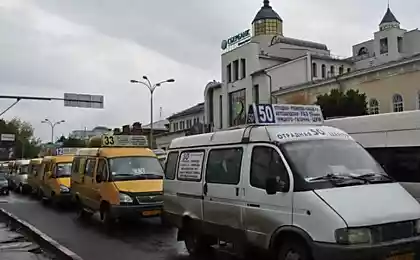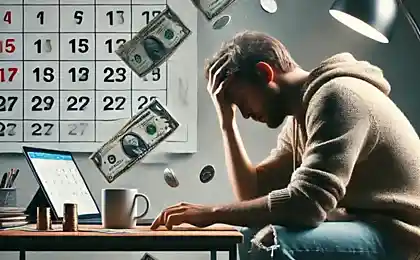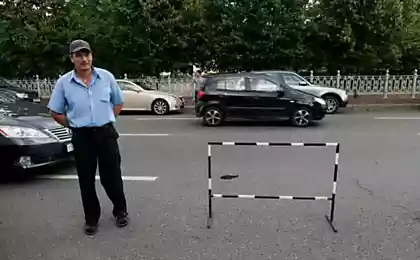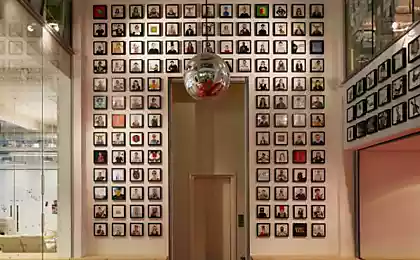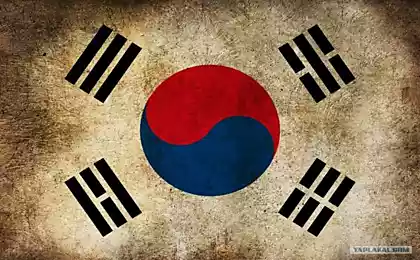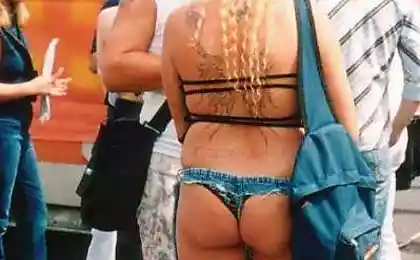1000
How to deal with traffic jams, and why does this Municipality
Writes blogger maxkatz:
Today let's talk about the system to combat congestion in general, on how to deal with them trying to Moscow Mayor's Office, and that is why they do everything wrong
16 pictures and letters
* Figures may be malfunctioning, please do not get attached to them is important the general idea.
At the inhabitant of the city, there are two main alternatives, how to navigate to and all around the city - private car and public transportation. Man taking this decision, weighing the three basic parameters: the price of travel, speed of travel and comfort. It is clear that different people have different opinions on these parameters - someone in the truck so uncomfortable that he is ready at least 10 times longer to go, if only by car. However, we are not interested in private extreme cases, we are interested in the average for all residents of the behavior, and it is always very pragmatic.
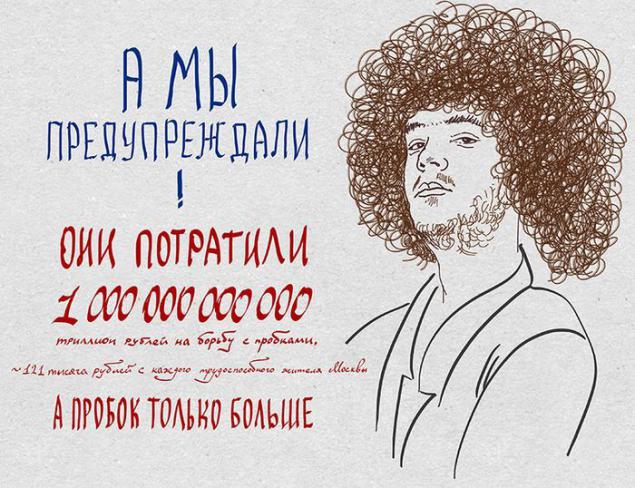
As a result, the results of weighing each person, exactly how it is more profitable to go to work, we get the balance of the city's transport system - a certain number of people moving on the car, and some public transport.

Below, we see how these percentages are formed and why.
Despite the fact that the "transportation system" is one unit, two of its parts (automotive, public transportation) is very different properties. So different that some politicians consider them two different systems to be developed separately from each other. To motorists, and it was convenient, and those who are traveling by public transport. And we will build the underground and the roads, and all will be well. In fact, this is misleading - the system alone, but she had two different managers.
The main difference between units is that the roads are very vulnerable to overload and the more it goes on the people, the less quality service they provide. Ride on them becomes longer, less comfort, capacity drops, etc.
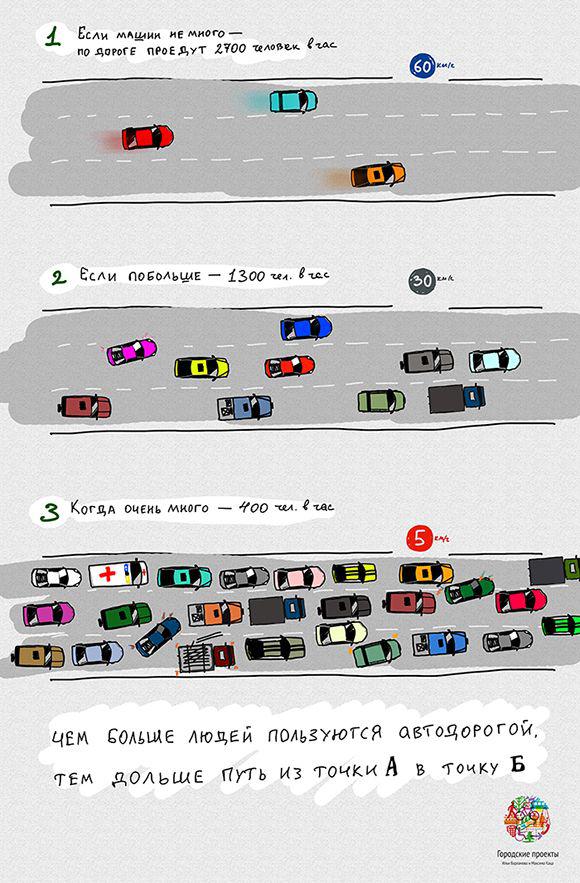
And with public transport all the way around - the more people traveling on the route, the more high-quality service they receive: transport is increasingly becoming more convenient, more can spend money on infrastructure. As a result, and is a more reliable and comfortable transport.
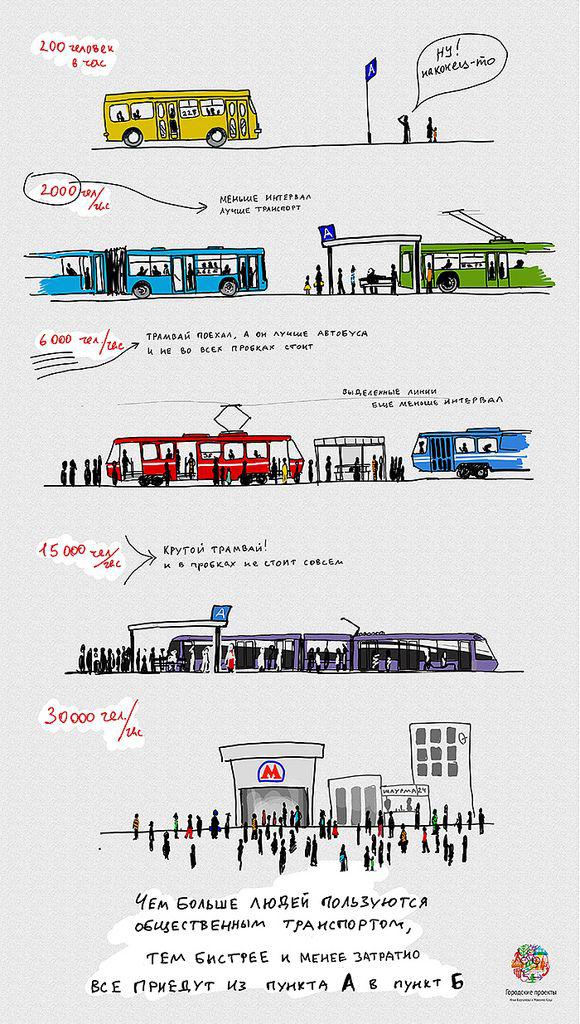
All this is completely market-based mechanisms - 15, 000 people per hour simply advantageous to carry through a dedicated lane at a convenient tram system, is much more profitable than chasing a million buses. And for 30, 000 people is more profitable to build a subway - that is, it is not some artificial regulation, they say, will make convenient transportation, since it there so much. This is a natural process.
If we generalize - every motorist loses in speed and comfort when on the road leaves the other motorist. And each passenger public transport wins in speed and comfort when he travels from another passenger.
To put these two ideas on the chart, you get something like this:
Automotive. When there is a traffic jam on the road - travel time increases dramatically for the entire system. It is crucial that the road never traveled more cars than it is able to skip.

Now, public transport - all the way around. Please note, we launched a graph from right to left instead of left to right, it's done on purpose:

Under "costs" included the totality of the costs - money, time travel and the discomfort arising from the trip a bit difficult moment now - to understand how the system works, you need to combine the two into a single graph. Get this:
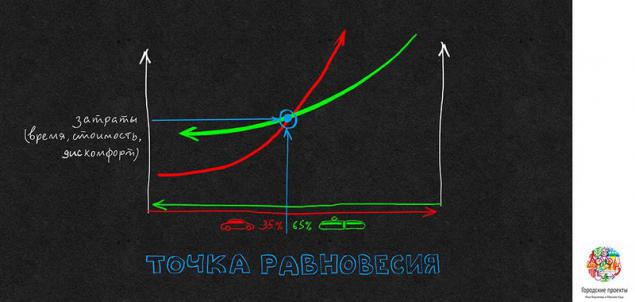
All passenger traffic decides to go it by public transport or by car. This decision depends on factors we have discussed above, and at some point, the system comes into equilibrium - a certain part of people use public transport, and the other part of the car. This point is called "personal balance". If your system does not have any effect, it will come into balance here at this point, and a certain percentage of people will travel by public transport, and the other by car. This will take place because both of these types of movement are equally "benefit».
For a period of time the system can pick up and move, for example, in such a manner.

But then a certain number of motorists quickly realize that transport to travel much faster then change it, and the system returns to equilibrium.
Or vice versa, for a short while the situation may be such:

But then some of those who use transport, realize that they spend much more time than they would in the case of travel by car, and then they change on cars, and the system will come back into balance.
That is, once again: the system always comes into equilibrium - the level of the total cost turns out the same on both systems. If suddenly in some of the systems it is lower than the other, people are moving back and he again becomes the same.
But sometimes under the influence of various factors can shift the equilibrium point itself. An example of a natural change, which everyone knows: there are quite a large group of people who use the car only in summer, and in winter the city goes to the subway. Why is this happening? Because the winter because of the snow slows down the speed of movement, and the total cost of travel by car increased. Therefore, some people are transferring to transport, and the system comes into balance, on another point. Motorists are now smaller, and users from more

What is in this story goal of City Hall? The purpose of the mayor's office - to make sure that the average cost of a trip around the city declined. That is to ensure that the equilibrium point fell below the axis of the costs. If it is below, it means that the average trip through the city is faster, cheaper, more comfortable for all participants: both those traveling in the truck, and those traveling by car.
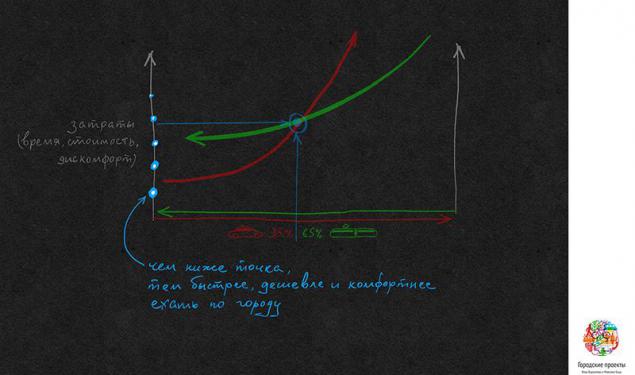
Let's look at some measures that could take mayor's office, and how they are reflected in the graph on the average cost per trip.
For example, allowing free parking on sidewalks. This measure reduces the costs of the trip by car (in fact searching for a parking space occupies a considerable part of the travel time, there was a look quickly - the trip more attractive). It turns red graph is shifted downwards. That's what comes to the point:
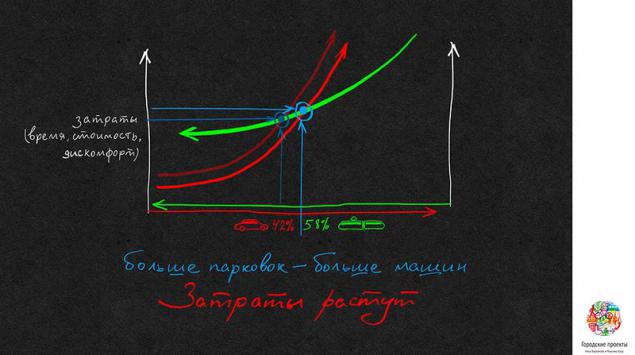
The average trip was longer (more expensive, less comfortable). And it has become more costly for both systems, motorists after the measure was too difficult to ride, since the number of cars in the city has increased. We're here for simplicity do not consider that the attractiveness of public transport decreased slightly due to the fact that it became difficult to walk around the city.
Or, for example, take the construction of a new road bessvetofornoy. Leningradku done so, now want Leninsky Prospect. There is little change in the other - we have increased the capacity of the road, then later became a red graph fly up - now more people can go on the road quickly.

More people moved to the cars, the average trip was longer.
That is, the construction of highways default makes moving around longer and more expensive, this measure (except in rare cases, when we are a small road connects the areas and eliminate the big hook) always leads to a deterioration in the traffic situation in the city.
Let's look at another step undertaken by the Municipality, - marking dedicated lanes. It reduces the capacity for vehicles (red graph goes up earlier), public transport has now become faster ride (green chart is below)
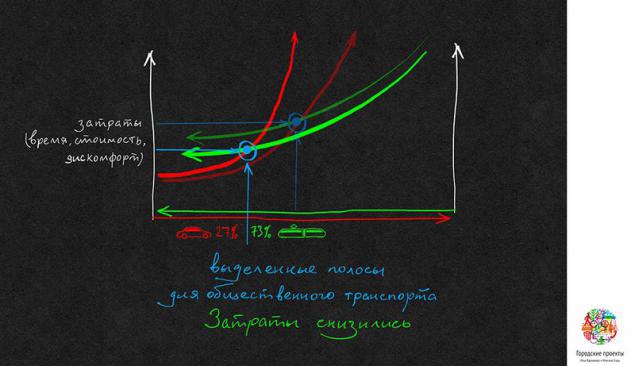
Average trip was shorter (less / more comfortable) for both systems! Motorists also drove faster than average because their traffic was less.
In general, the task of the mayor's office - to encourage use of public transport and discourage the use of private cars.
Encourage transport can be:
the introduction of trams, light-rail, dedicated bus lanes,
acceleration of existing systems (eg turnstiles removed),
lower prices for travel, the organization of a single ticket,
construction of the metro,
purchase comfortable buses, trolley buses and trams.
Discourage travel by car:
the introduction of a variety of cards (for parking, the fare to the center, the gas tax, vehicle purchase tax), dismantling of existing roads and parking spaces (so solve the problem of traffic jams in Denmark).
If you do this - the average speed of movement of people in the city will grow.
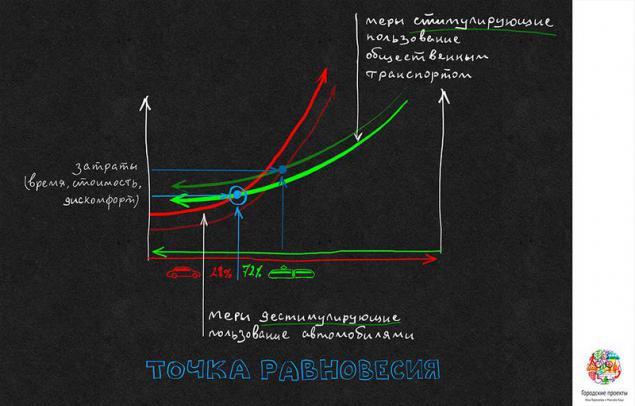
Our Municipality currently takes a populist stance - it tries to stimulate and use of cars (road building, increasing the number of parking spaces) and a trip to transport (purchase new machines, building the subway, making dedicated lanes). Let's look at the budget of Moscow.
The construction of new roads, parking lots and general infrastructure for motorists for the 2012, 2013 and 2014 will spend 558 billion rubles. The development of public transport, including the construction of the subway, will spend 466 billion rubles. That is 57% of the budget will go to the development of road infrastructure, and 43% of the budget will go to the development of public transport.
City Hall continues to do what worsen the transport situation in the city, encouraging movement by car. For every motorist during these 3 years the City Hall will spend ~ 186,000 rubles (in Moscow nearly 3 million cars). For each passenger as public transport city will spend ~ 55 thousand rubles.
These measures will lead to the fact that after three years there will be more traffic jams. Just by the way will fall election of the mayor, who is 3 years and planning.
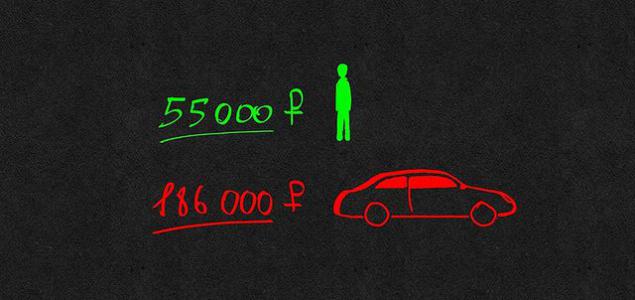
Source:
Today let's talk about the system to combat congestion in general, on how to deal with them trying to Moscow Mayor's Office, and that is why they do everything wrong
16 pictures and letters
* Figures may be malfunctioning, please do not get attached to them is important the general idea.
At the inhabitant of the city, there are two main alternatives, how to navigate to and all around the city - private car and public transportation. Man taking this decision, weighing the three basic parameters: the price of travel, speed of travel and comfort. It is clear that different people have different opinions on these parameters - someone in the truck so uncomfortable that he is ready at least 10 times longer to go, if only by car. However, we are not interested in private extreme cases, we are interested in the average for all residents of the behavior, and it is always very pragmatic.

As a result, the results of weighing each person, exactly how it is more profitable to go to work, we get the balance of the city's transport system - a certain number of people moving on the car, and some public transport.

Below, we see how these percentages are formed and why.
Despite the fact that the "transportation system" is one unit, two of its parts (automotive, public transportation) is very different properties. So different that some politicians consider them two different systems to be developed separately from each other. To motorists, and it was convenient, and those who are traveling by public transport. And we will build the underground and the roads, and all will be well. In fact, this is misleading - the system alone, but she had two different managers.
The main difference between units is that the roads are very vulnerable to overload and the more it goes on the people, the less quality service they provide. Ride on them becomes longer, less comfort, capacity drops, etc.

And with public transport all the way around - the more people traveling on the route, the more high-quality service they receive: transport is increasingly becoming more convenient, more can spend money on infrastructure. As a result, and is a more reliable and comfortable transport.

All this is completely market-based mechanisms - 15, 000 people per hour simply advantageous to carry through a dedicated lane at a convenient tram system, is much more profitable than chasing a million buses. And for 30, 000 people is more profitable to build a subway - that is, it is not some artificial regulation, they say, will make convenient transportation, since it there so much. This is a natural process.
If we generalize - every motorist loses in speed and comfort when on the road leaves the other motorist. And each passenger public transport wins in speed and comfort when he travels from another passenger.
To put these two ideas on the chart, you get something like this:
Automotive. When there is a traffic jam on the road - travel time increases dramatically for the entire system. It is crucial that the road never traveled more cars than it is able to skip.

Now, public transport - all the way around. Please note, we launched a graph from right to left instead of left to right, it's done on purpose:

Under "costs" included the totality of the costs - money, time travel and the discomfort arising from the trip a bit difficult moment now - to understand how the system works, you need to combine the two into a single graph. Get this:

All passenger traffic decides to go it by public transport or by car. This decision depends on factors we have discussed above, and at some point, the system comes into equilibrium - a certain part of people use public transport, and the other part of the car. This point is called "personal balance". If your system does not have any effect, it will come into balance here at this point, and a certain percentage of people will travel by public transport, and the other by car. This will take place because both of these types of movement are equally "benefit».
For a period of time the system can pick up and move, for example, in such a manner.

But then a certain number of motorists quickly realize that transport to travel much faster then change it, and the system returns to equilibrium.
Or vice versa, for a short while the situation may be such:

But then some of those who use transport, realize that they spend much more time than they would in the case of travel by car, and then they change on cars, and the system will come back into balance.
That is, once again: the system always comes into equilibrium - the level of the total cost turns out the same on both systems. If suddenly in some of the systems it is lower than the other, people are moving back and he again becomes the same.
But sometimes under the influence of various factors can shift the equilibrium point itself. An example of a natural change, which everyone knows: there are quite a large group of people who use the car only in summer, and in winter the city goes to the subway. Why is this happening? Because the winter because of the snow slows down the speed of movement, and the total cost of travel by car increased. Therefore, some people are transferring to transport, and the system comes into balance, on another point. Motorists are now smaller, and users from more

What is in this story goal of City Hall? The purpose of the mayor's office - to make sure that the average cost of a trip around the city declined. That is to ensure that the equilibrium point fell below the axis of the costs. If it is below, it means that the average trip through the city is faster, cheaper, more comfortable for all participants: both those traveling in the truck, and those traveling by car.

Let's look at some measures that could take mayor's office, and how they are reflected in the graph on the average cost per trip.
For example, allowing free parking on sidewalks. This measure reduces the costs of the trip by car (in fact searching for a parking space occupies a considerable part of the travel time, there was a look quickly - the trip more attractive). It turns red graph is shifted downwards. That's what comes to the point:

The average trip was longer (more expensive, less comfortable). And it has become more costly for both systems, motorists after the measure was too difficult to ride, since the number of cars in the city has increased. We're here for simplicity do not consider that the attractiveness of public transport decreased slightly due to the fact that it became difficult to walk around the city.
Or, for example, take the construction of a new road bessvetofornoy. Leningradku done so, now want Leninsky Prospect. There is little change in the other - we have increased the capacity of the road, then later became a red graph fly up - now more people can go on the road quickly.

More people moved to the cars, the average trip was longer.
That is, the construction of highways default makes moving around longer and more expensive, this measure (except in rare cases, when we are a small road connects the areas and eliminate the big hook) always leads to a deterioration in the traffic situation in the city.
Let's look at another step undertaken by the Municipality, - marking dedicated lanes. It reduces the capacity for vehicles (red graph goes up earlier), public transport has now become faster ride (green chart is below)

Average trip was shorter (less / more comfortable) for both systems! Motorists also drove faster than average because their traffic was less.
In general, the task of the mayor's office - to encourage use of public transport and discourage the use of private cars.
Encourage transport can be:
the introduction of trams, light-rail, dedicated bus lanes,
acceleration of existing systems (eg turnstiles removed),
lower prices for travel, the organization of a single ticket,
construction of the metro,
purchase comfortable buses, trolley buses and trams.
Discourage travel by car:
the introduction of a variety of cards (for parking, the fare to the center, the gas tax, vehicle purchase tax), dismantling of existing roads and parking spaces (so solve the problem of traffic jams in Denmark).
If you do this - the average speed of movement of people in the city will grow.

Our Municipality currently takes a populist stance - it tries to stimulate and use of cars (road building, increasing the number of parking spaces) and a trip to transport (purchase new machines, building the subway, making dedicated lanes). Let's look at the budget of Moscow.
The construction of new roads, parking lots and general infrastructure for motorists for the 2012, 2013 and 2014 will spend 558 billion rubles. The development of public transport, including the construction of the subway, will spend 466 billion rubles. That is 57% of the budget will go to the development of road infrastructure, and 43% of the budget will go to the development of public transport.
City Hall continues to do what worsen the transport situation in the city, encouraging movement by car. For every motorist during these 3 years the City Hall will spend ~ 186,000 rubles (in Moscow nearly 3 million cars). For each passenger as public transport city will spend ~ 55 thousand rubles.
These measures will lead to the fact that after three years there will be more traffic jams. Just by the way will fall election of the mayor, who is 3 years and planning.

Source:

